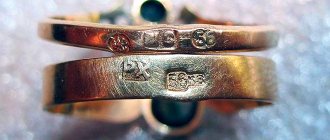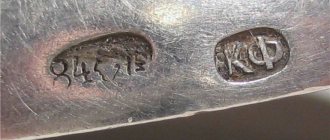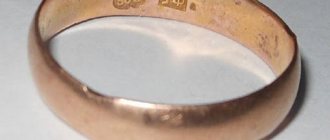What kind of sample is this
On jewelry made before 1927, 56 was the most common. Usually, thanks to the mark on these jewelry, you can find out who made the product. Jewels with raised markings are of particular importance, since only after 1897 marks began to be made depressed, similar to modern ones. Compared to today's standards, 56 corresponds to 585 gold.
Briefly about the history of appearance
Mandatory marking on products made of precious metals was introduced by Peter I. The spool system was adopted to systematize the quality of gold, control accounting and at the same time bring order to the jewelry industry. Until 1733, products were made without sample. The proposed classification was used until 1927.
The first sample of gold in Russia
In Russia, the sample designation was introduced much later than in other European countries. Branding of the precious metal on the territory of the Russian state began only in 1700 during the reign of Peter I. During his reign, coins were 98% pure gold and had only 2% copper. To check the authenticity of the coins, they were tested by teeth, since gold is a very soft metal.
To this day, the tradition of biting the award has been preserved among athletes, letting everyone know that a gold medal has been won. Although now they are not actually made from pure metal, but are only coated with a small layer of gold.
Composition and properties
To make this sample, 56 parts of pure gold and 40 parts of alloys were used. In terms of properties, quality and composition, it corresponds 100% to modern 585 standard. The following metals were often used as alloys:
- silver;
- copper;
- nickel;
- zinc;
- brass;
- palladium.
Such alloys changed the color of the alloy, its ductility and wear resistance. Palladium increased the price of the product several times due to its cost.
Strength
Products made from 56 standard have fairly high strength. The strongest jewelry is considered to be made from an alloy containing nickel, brass or zinc. In addition, this ligature made it possible to create various woven patterns on the decoration.
Alloy shade chart
| Color | Share of gold | Silver | Copper | Nickel |
| Pink (red) | 58.5% | 9% | 32.55% | — |
| Yellow | 58.5% | 18.75% | 22.75% | — |
| Pale yellow | 58.5% | 28% | 13.5 | -? |
| Yellow-green pale | 58.5% | 38.25% | 3.25% | -? |
| White | 58.5% | 25.5% | — | 16.5% |
Expert opinion
Vsevolod Kozlovsky
6 years in jewelry making. Knows everything about samples and can identify a fake in 12 seconds
Palladium changed the properties of products; it did not have a significant effect on color.
Brand
Until 1897, items made from 56 samples were marked with a raised mark. In the 20th century, only depressed ones were done. You can see what it looks like in the photo.
How many carats are in this sample?
The spool system was used in Tsarist Russia, while the metric system was used in the Soviet Union. In the West, the carat system is used to measure fineness.
| Spool value | Metric value | Carat value |
| 56 | 585 | 14 |
Alloy Application
Gold of this type was used to make jewelry and various types of jewelry. Most often, the 56 sample can be found on rings and rings, but it was also used to create earrings, chains, bracelets, crosses, pendants and other products. Today it is used more often than others for making wedding rings.
In the Soviet Union, such a test was used in almost all gold products, marking them with the 585 stamp.
Interestingly, until 1914, this gold alloy was used, among other things, to make Olympic medals and sports cups.
56-carat gold. Tsar's Jewelry
Home ~ Articles ~ 56-carat gold. Tsar's Jewelry 56-carat gold: Tsar's gold Let me introduce myself, my name is Oleg and I have devoted most of my life to collecting, including jewelry. In this material I would like to introduce you to the rare and valuable 56 hallmark in products and gold coins ; gold with such engraving is also called royal.
Why did the metal get such a name, what are its features, where does the demand come from and how much can products with number 56 cost? Here you can find answers to any questions.
History and characteristics of royal gold
The number 56 on gold jewelry speaks, first of all, about the advanced age of the jewelry.
They carry real historical value; mandatory marking with this hallmark was introduced by Peter the Great; the spool system was necessary for control, accounting of jewelry and their quality. This engraving was applied until 1927, but the greatest value is found in jewelry with raised markings - this method was used until 1897. Then the craftsmen began to use the pressed image, as on modern products.
The marking carried information not only about the composition and percentage of precious metals, but also sometimes about the creator of the product. The 56 mark in composition fully corresponds to the modern 585 standard and says that the product contains 56 parts of pure gold and 40 impurities of other metals from:
- brass;
- copper;
- silver;
- palladium;
- nickel;
- zinc
The amount of these metals in the alloy affects the shade and ductility of the material, which allowed craftsmen to create sophisticated jewelry; moreover, 56 sample was famous for its high strength and durability.
So how much can royal gold cost?
The cost of such a thing today depends on several indicators:
- the presence of the master's mark significantly increases the price of the product;
- Year of manufacture;
- the presence of precious stones, of course, adds value;
- confirmation that the product was in the possession of a famous person of those times, or has a rich history.
If there are no such marks on the product, 1 gram of 56 sample can cost about 1,500 - 3,000 rubles. But original jewelry with such engraving will not be available in a regular jewelry store. Such products are dealt with by private individuals, antique dealers or pawn shops.
Earrings 56 samples
Few people know, but earrings were originally created in ancient times as jewelry for men.
But ear accessories came to Tsarist Russia as a female attribute, much later. The Orthodox Church did not approve of bodily changes, so earrings gained real popularity already under Elizabeth, just at the time of widespread jewelry making. Earrings changed their shape and grew in price. One could often find 56-karat items with sapphires, emeralds, demantoids and even diamonds. Only very rich and influential people could afford jewelry with these stones, and craftsmen performed such work with special reverence, as if it were their calling card.
Despite the rarity of items made from royal gold, the modern market and online auctions offer a wide variety of goods at very different prices. Let's look at just a few examples.
1. The price of such earrings with diamonds is 270,000 rubles.
2. These earrings using turquoise and 2.8 grams of gold (1908-1917) are valued at 28,000 rubles.
3. These sophisticated and unusual products using 8.4 grams of royal gold can cost about 35,000 rubles.
4. The cost of older products is much higher. For example, this product contains only 4.04 grams of gold, the insert is made of amber, but the price reaches 100,000 rubles, due to its age. The earrings have a raised engraving, indicating that they were created before 1917.
Bracelets made of royal gold
The bracelet also did not immediately become an ordinary piece of jewelry; in ancient times, such accessories served ancient peoples as a talisman to protect them from evil spirits and troubles. In Rus', such jewelry appeared later than in other countries, around the 11th-13th centuries, and bracelets turned into valuable jewelry only in the Renaissance.
5. This bracelet dates back to 1880-1900. 11.25 grams of gold is valued at more than 100,000 rubles.
6. This sophisticated specimen in the form of a strap weighing 19 grams also costs a little more than 100,000 rubles.
7. And the price of such a bracelet, inlaid with diamonds and diamonds, around 1880-1910. can reach up to 200,000 rubles.
Watch 56 samples
The first wristwatches appeared at the end of the 19th century, but the aristocracy used only pocket watches fastened with a chain to their vest; wristwatches became widespread only in the 20-30s of the 20th century. Pocket watches continued to show not only the time, but also the high social status of the owner for a long time. Both types of watches made of royal gold have great value on the antiques market.
8. For example, one of the online stores offers to buy this pocket watch for 220,000 rubles.
9. Such women's wristwatches on a thin bracelet in an antique case cost about 50,000 rubles.
10. A gold watch decorated with diamonds from pre-revolutionary years can be bought for 65,000 rubles.
The age of such a watch is revealed not only by its mark, but also by the presence of only two hands: hour and minute. Seconds hands on watches appeared later, when the pace of life accelerated significantly and people began to value time.
How to sell royal gold?
Products with engraving 56 cannot be sold to anyone; in fact, there are only 2 options:
- Pawnshop. There, your products will most likely be valued at 585 standard, about 1,500 rubles per 1 gram. But sometimes the alloy does not correspond to composition 585 and is accepted at a price of 500 (1200 rubles) or 375 samples (950 rubles). In this case, it is better not to rush and visit several points; offers may be different.
- Antique shop or antique clubs. Antique experts are often only interested in very rare items. This does not apply to wedding rings, chains, bracelets or earrings.
The most popular antique store for 56 samples is the Assumption Club .
But here, too, it’s worth getting around as many experts as possible. They all specialize in different products, and the offers for purchasing your product may vary greatly.
Number of views:
803
Published:
02.26.2021
Go back →
All books and magazines by the authors of “Izba-Reading Room”
Advantages and disadvantages
56 (585) is considered a more valuable alloy than 583, which is most popular in jewelry stores today. But in terms of gold content, 56 is inferior to most samples on the precious metals market. Despite this drawback, it remains popular with us due to certain advantages:
- hardness and wear resistance;
- wide range of colors;
- increased strength and durability;
- plasticity, which allows you to create unique jewelry.
The alloy acquires these properties due to the content of various impurities in it: zinc, copper, palladium, silver, nickel, platinum. The amount of additives does not spoil the overall quality of gold, but only allows you to control its properties.
The relationship between the ancient and modern sampling systems
The spool test, like any other, shows the amount of pure gold in the product. In Tsarist Russia, 1 pound was equal to 96 spools. Therefore, the 56th sample product contains 56 spools of pure metal and 40 parts of additives (silver, palladium), they were added to give the metal various properties. The highest purity of gold was considered to be 96, which does not contain any impurities.
The modern metric system is based not on 96, but on 100 parts, in other words, the amount of pure gold per 100 milligrams (1 gram) of the alloy is indicated. In order to understand what the royal 56 standard is equal to, in the modern metric system you need to divide 56 by 96 and multiply the resulting result by 1000. As a result, it corresponds to 583 standard, which over time was equated to the 585th.
But it will also not cause any difficulties to convert the 56 spool sample into the carat system. It is accepted that pure gold is equal to 24 carats. 56 must be divided by 96 and the resulting number multiplied by 24. It turns out that royal gold of this standard is equal to a 14-karat alloy.
Jewelry of 56 samples is of historical rather than material value. But the connection between times and generations is much more expensive for many people, so increasingly such products remain in home collections rather than being put up for sale.
Where can I buy and sell such a sample?
Original 56 mark jewelry can only be purchased from antique dealers. But its metric analogue is available in almost any jewelry store. It was used more often in the Soviet Union, but even today this alloy is found quite often in various products. Jewelry marked 56 hallmark can only be purchased in antique stores, from private individuals or in pawn shops.
Pawnshop and antique dealer
The cost of products with the mark 56 is very high, as they have historical value. The most inexpensive will be wedding rings from pawn shops, inherited ones. But it is difficult to find such specimens.
The minimum price per gram of this alloy in antique shops and pawn shops is 2,000 rubles.
The price increases several times if the product contains precious stones, and the cost will be even higher if there is a jeweler’s mark. Some 56-carat jewelry has a seven-figure price tag.
The Eternal Value of Gold
Today, on the market, royal gold is valued by jewelers and pawnshops as 585 gold. In pawnshops, royal forging, the age of the item, and the possibility of belonging to a famous family are not taken into account. Anyone can buy such jewelry at a price taking into account all its historical value. Antique shops sell snuff boxes, brooches, earrings, rings, watches, ashtrays and other items from the 18th and 19th centuries at high prices.
The popularity of 56-carat antiques is obvious. The main advantages of purchasing antique jewelry:
- A rarity is a rare thing.
- A guarantee that you are looking at an expensive accessory or an item with its own history.
- Purchasing such gold is an investment. Over time they will only become more expensive.
How much does 1 gram of gold of this standard cost?
The price of gold is determined by the Central Bank of the Russian Federation. But the market value has different meanings for scrap and jewelry. Jewelry often has historical value, so its evaluation should be carried out by a specialist. In this case, the price is influenced by the presence of precious stones, the mark of the jeweler, who used the jewelry and other factors.
| Price 999 standard according to the Central Bank | Market value of the sample today | Scrap price | Price in jewelry |
Recommendations for care and cleaning
Products made from precious metals can change color, become dirty and lose their shine. To combat this, you need to clean your jewelry regularly. For this purpose, various means are used. Housewives often use soap solutions, ammonia, and hydrogen peroxide when wiping jewelry. But it is best to purchase a special jewelry paste.
Expert opinion
Vsevolod Kozlovsky
6 years in jewelry making. Knows everything about samples and can identify a fake in 12 seconds
Stores sell entire kits for caring for gold items.
Does gold darken
Darkening on gold products indicates the presence of foreign impurities and low quality of the alloy. 56 standard does not darken, as the quality of this type of gold is high. Slight darkening may occur on items from the 18th–19th centuries.
Why do gold items turn your fingers black?
If the skin of your fingers turns black when wearing a gold ring, this indicates excessive sweating. As a result of the reaction of metal and human sweat, blackening appears. According to experts, it is possible that your menu contains too much meat products. Popular superstitions claim that blackening is a sign of a serious illness or damage to a person.
Appearance of gold streaks
Streaks can appear when a person wearing gold jewelry comes into contact with smoke or soot. Sometimes the cause is excessive sweating. To combat blackening and the appearance of streaks, use high-quality hand cosmetics, wear gloves when working and regularly check your health.
What does sample number 56 mean?
Sample is an assessment of the quality of the alloy from which a piece of jewelry or other item is made. It shows the ratio of ancient gold to the gold-bearing composition, how many gold parts are in 96 parts of the alloy. Performing an arithmetic operation, it is determined that 56 is the purest precious metal.
56-carat jewelry contains 56 parts of gold, the remaining 40 are an alloy of various metals, which is designed to give it color and flexibility.
Tips for choosing gold jewelry
Purchasing a gold item is a serious procedure. You need to analyze prices and quality in different jewelry stores, checking first of all the following:
- grinding quality;
- uniformity of the surface of the product;
- absence of defects: cracks, depressions, abrasions, dents, breaks, scratches;
- quality of decoration.
In addition, you should pay attention to the tag - a kind of passport of the jewelry. It must be formatted correctly and contain the following information: manufacturer, name;
- company address or contact details;
- the name of the product itself;
- type of metal and its purity;
- weight;
- price.
Expert opinion
Lyudmila Pestereva
Our most experienced gold investor
Ask a Question
Tags that do not have this information are not considered a passport of the product and indicate poor quality of the jewelry, possible counterfeiting and cheapness.
Let's talk about fakes
Another point that those who like to buy antique jewelry should pay attention to is the authenticity of the jewelry. For many years there has been a whole industry of counterfeits of ancient coins, jewelry, precious stones, paintings, etc. Therefore, on the world market (and Russia in this case is no exception) you can easily buy an “antique ring of the 18th century” made by masters of counterfeiting somewhere in Romania or Turkey.
Here are some simple recommendations on how to avoid purchasing counterfeits on the jewelry market and what measures should be taken to avoid becoming a victim of scammers:
- When purchasing jewelry, bars or coins in a store or, for example, in a bank, there must be a certificate. Very often, jewelry boutiques limit themselves only to the tag on the jewelry, which indicates the manufacturer, sample, weight and price. In fact, there should be a certificate, if not for each product, then for the entire batch. Otherwise, the Russian Assay Chamber would not allow trade.
- When buying second hand or at some auctions, it is best to use the services of expert jewelers. It’s better to have to pay a specialist for his consultations than to not sleep at night worrying about the fact that you bought a fake or a product that’s not worth the money you paid.
- When purchasing gold jewelry abroad, you should understand that they have their own standards of measure and weight, price and quality. Therefore, before you go for Turkish gold, it is best to search on the Internet for a list of licensed stores and boutiques in the country, where you are less likely to buy aurum in the form of bronze or brass.
In conclusion, it only remains to add that, of course, gold, as decoration and an investment “just in case,” has not lost its significance. But when buying gold jewelry, you need to be careful and understand at least a little about what kind of masterpiece you are purchasing, and sometimes for a lot of money.
Reviews
Maria:
“My grandmother gave me a ring, no stone, just a nice ring with a small pattern. On the inside there is an o, which, as I later learned, means a test. At first I doubted that we have a three-digit standard system for gold. I googled it and it turned out to be simple: the ring was made back in the days of the spool system. What can I say - the ring is beautiful, it has not changed color, does not darken and does not stain the skin. Grandma clearly looked after him, I continue this tradition.”
Konstantin:
“A chain with 56 hallmarks, the lock broke, I turned to the jeweler for help. He suggested installing a new one, made from a modern alloy. There was no choice - I had to replace it. And a year later I got caught on the railing and pulled the chain hard, so the new lock broke, but my father’s 56-grade chain was not damaged anywhere.”
Arina:
“Good gold was made in Tsarist Russia, my father has a ring that has been inherited for several generations, the 56th standard is marked with a hallmark. It does not turn black, does not stain the skin, and does not need to be cleaned often - it’s a pity that there are no such good alloys today.”











